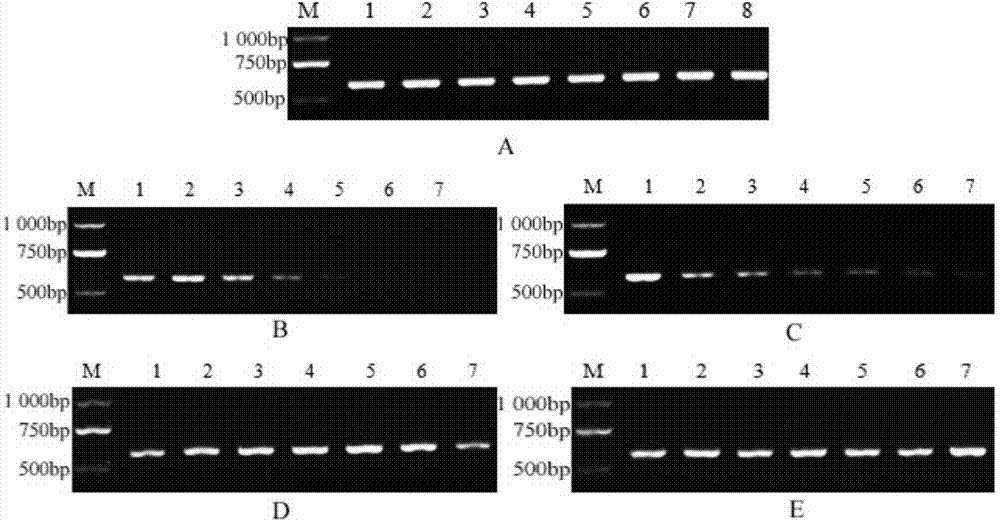Method for rapidly diagnosing shrunken-fruitsclerotiniose of mulberry
A technology for rapid diagnosis and sclerotinia, applied in the field of plant disease prevention and control, to achieve accurate and reliable detection results, high sensitivity, and convenient and quick use
- Summary
- Abstract
- Description
- Claims
- Application Information
AI Technical Summary
Problems solved by technology
Method used
Image
Examples
Embodiment 1
[0025] Embodiment 1: the extraction of testing material DNA . The aforementioned test strains were inoculated on the PDA medium with cellophane, Sclerotinia, Botrytis cinerea and Trichoderma were cultured in the dark at 20°C for 2 days, and the pathogenic bacteria of Sclerotinia mulberry were cultured in the dark at 25°C for 15 days and the mycelia were collected. Using the CTAB method (( Liu Li, Zhang Yongjun, Xu Changzheng, Luo Feng. An improved CTAB method for DNA extraction of polysaccharide-producing fungi. Chinese Journal of Biotechnology, 2014, 34(5): 75-79 ) to extract the genomic DNA of plant tissues such as fungus and mulberry, and the soil samples refer to Woodhall et al. ( Woodhall J W, Webb K M, Giltrap P M, Adams I P, Peters J C, Budge G E, Boonham N. A new large scale soil DNA extraction procedure and real-time PCR assay for the detection of Sclerotium cepivorum in soil. European Journal of Plant Pathology, 2012, 134(3): 467-473 ), the concentration and qual...
Embodiment 2
[0026] Example 2: Acquisition of specific conserved fragments of DNA of G. nuclei. First, RAPD (random amplified polymorphism DNA)-PCR technology was used to amplify and screen out the specific conserved DNA fragment sequence of G. nucleatum. The 40 random primers used were synthesized by Shanghai Sangong. Referring to Williams et al. ( Williams J G K, Kubelik A R, Liv S ak K J, Rafalski J A,Tingey V. DNA polymorphisms amplified by arbitrary primers are useful as genetic markers. Nucleic Acids Research, 1990, 18(22): 6531-6535 ), the total volume of each RAPD amplification reaction PCR is 25 μL, including 2.5 μL 10×PCR Buffer; 1.5 μL Mg 2+ (25mmol / L); 2μL dNTPs (2.5mmol / L); 1μL 10mM random primer, 1μL DNA template, 0.25μL rTaq enzyme (2.5U / μL); 2 O make up. The amplification program was as follows: pre-deformation at 94°C for 5 min; denaturation at 94°C for 30 s, annealing at 36°C for 30 s, extension at 72°C for 1.5 min, 35 cycles; final extension at 72°C for 10 min and s...
Embodiment 3
[0030] Example 3: SCAR specific primer design and screening . According to the sequence of the specific fragment, 20 pairs of SCAR primers were designed with Premier 5.0 software, and the designed primer pairs were synthesized by Shanghai Sangon Biotechnology Co., Ltd. These 20 pairs of primers were screened by PCR, and a pair of best specific primers SS-F / SS-R were screened from these primers. The forward sequence SS-F of the primer is 5'- AGTAAAGAGAACATCAAACTTCG -3', located at 8 bp-30 bp of the specific sequence; the reverse sequence SS-R is 5'- ACTTCC ACCGACCA ATCT -3', located at 580bp-596bp of the specific sequence , the target fragment is 590 bp (see the underlined part in the sequence listing).
PUM
 Login to View More
Login to View More Abstract
Description
Claims
Application Information
 Login to View More
Login to View More - R&D Engineer
- R&D Manager
- IP Professional
- Industry Leading Data Capabilities
- Powerful AI technology
- Patent DNA Extraction
Browse by: Latest US Patents, China's latest patents, Technical Efficacy Thesaurus, Application Domain, Technology Topic, Popular Technical Reports.
© 2024 PatSnap. All rights reserved.Legal|Privacy policy|Modern Slavery Act Transparency Statement|Sitemap|About US| Contact US: help@patsnap.com










